Physical Address
304 North Cardinal St.
Dorchester Center, MA 02124
Ever since man has gone to war, civilizations have made preparations for the care of battlefield casualties. The earliest written reports of such battlefield care date back to the Egyptians with the Edwin Smith Papyrus, an ancient Egyptian medical text named after its procurer. Throughout history the majority of contributions to combat casualty care have focused on the individual casualty and the specifics of the wounds rather than the system as a whole. Greek physician Hippocrates, in the fourth and fifth centuries bc, taught that wound suppuration was the key to healing. The flourishing Roman Empire brought the works of Galen from 130 to 200 ad. His writings included novel surgical techniques for suturing intestines and approaches to trepanning the skull. In the Middle Ages, the French surgeons Henri de Monteville and Guy De Chauliac devoted their lives to the surgical techniques and the treatment of wounds. Ambroise Paré’s “healing salve” and Jean Louis Petit’s screw tourniquet were major advancements adding to the management of war wounds at the time.
For the burgeoning United States, it did not take long to realize it was unprepared for managing battlefield injuries. In the first few months of battle in 1775, casualties were found scattered among homes and public facilities, receiving care from a variety of physicians with various levels of training. To address this issue, the Second Continental Congress formed the Hospital Department of the Army and appointed John Morgan as the Director. Morgan ventured to organize a trauma care system by centralizing casualty care to general hospitals. While he succeeded in funneling these patients into one location, care was ultimately jeopardized due to poor resource availability.
At the turn of the 19th century the War of 1812 and the Napoleonic wars brought about radical changes in the care of combat casualties. The most notable contributions came from Dominique Jean Larrey with his invention of the first ambulance, termed the “flying ambulance,” allowing for casualties to be treated during battle instead of traditionally at the end. He is also credited with developing the first triage system so that patients were treated based on extent of injury instead of by rank.
The late 19th century and the Civil War gave rise to many advances in battlefield wound care. The hospital sanitation was improved, credentialing of surgeons was required, and the use of anesthesia was common. Perhaps the most important contributions came from the “Father of Modern Battlefield Medicine,” Jonathan Letterman, who developed a formal Army Ambulance Corp. He also instituted a triage system so that for the first time in history, casualties were transported in a more expeditious fashion, regardless of rank, instead of lying on the battlefield in agony for days waiting to be treated.
From a trauma systems standpoint, it was not until World War I when an integrated system was developed by the Russian surgeon Vladimir Oppel. A proponent of the “right operation for the right patient at the right location at the right time,” he witnessed unacceptable morbidity and mortality during the war. His experience with these inefficiencies with trauma care resulted in the development of echelons of care from battlefield treatment to long-term rehabilitation. He built a system centered on the concepts of moving surgical care closer to point of injury, using subspecialty surgeons, and creating a reserve of readily deployable surgeons. Oppel’s teachings and system of practice were cultivated by many armies in World War II.
The kinetic nature of World War II as compared with the trench warfare of the World War I resulted in a more substantial push to move surgical care closer to the point of injury. This led to the development of the Auxiliary Surgical Groups, mobile surgical units designed to bring surgical care to the front lines. World War II also saw the advent of large-scale transcontinental aeromedical evacuation. These fledging, yet groundbreaking, advancements evolved throughout the Korean War with the use of helicopter evacuation, in order to evacuate casualties around the rocky terrain in Korea, and with the establishment of Mobile Army Surgical Hospitals, based on the Auxiliary Surgical Groups of World War I.
During the Vietnam War, helicopter evacuation blossomed while the beginning of a trauma registry was developed through the diligent work of then-Major Norman Rich, an Army vascular surgeon, who created a registry for all of his patients to later provide longitudinal follow-up ( Fig. 1 ). Though short-lived, lessons learned from the U.S. conflicts of the late 20th century led to the development of Tactical Combat Casualty Care, Critical Care Air Transport Teams, and data collection teams.
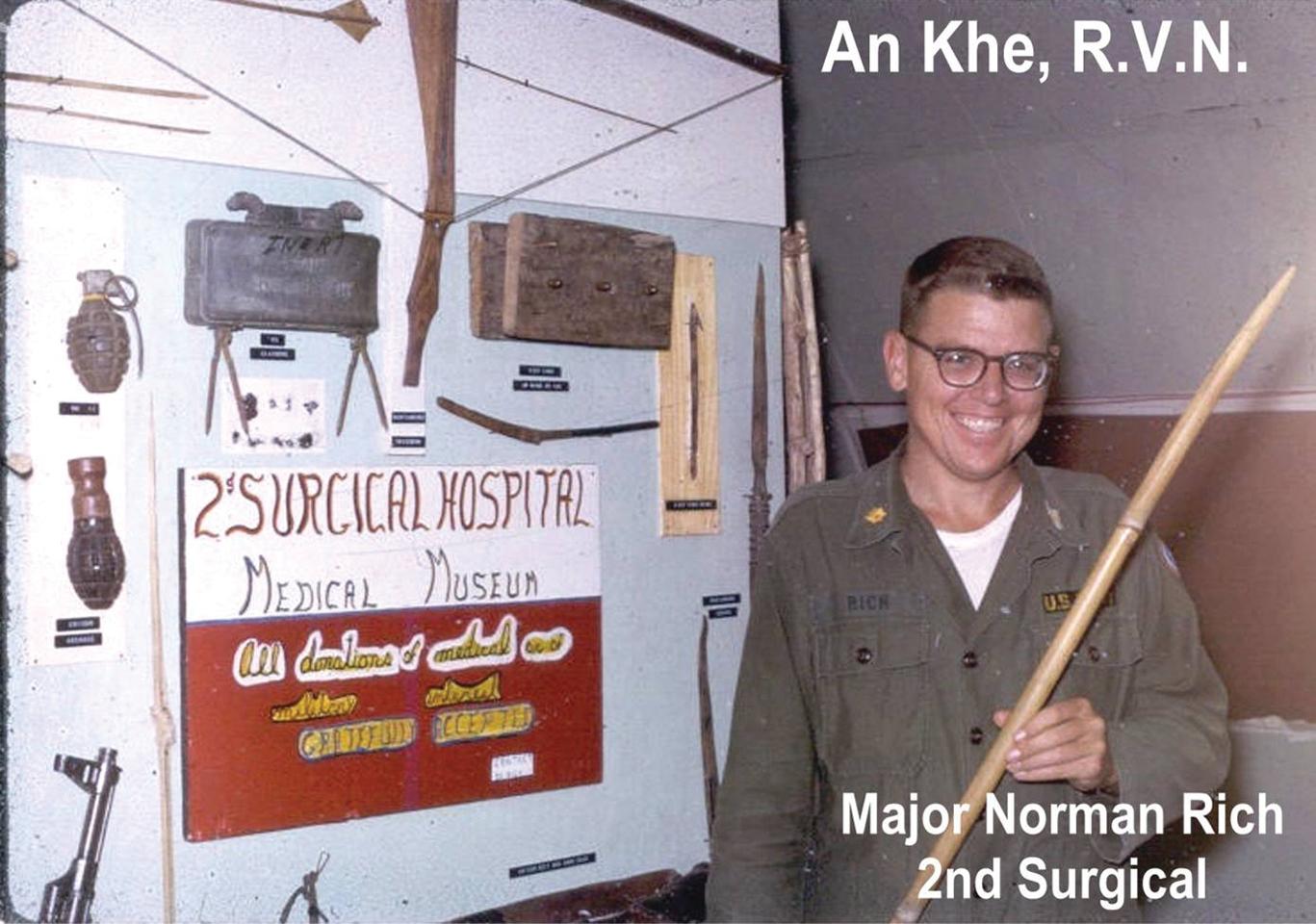
Arguably, the most significant progress toward battlefield care may have occurred within the last century. Improving the functionality of the military trauma system has only been successful through the continued evaluation of combat casualty care.
In the years subsequent to World War II, the Korean War, and the Vietnam conflict, military advancements in casualty care were incorporated into civilian trauma care including aeromedical evacuation and trauma resuscitation. In addition, a formal system for trauma care including trauma education and regional trauma networks was implemented in the United States. The Joint Trauma System (JTS) and Joint Theater Trauma System (JTTS) were among the medical readiness initiatives implemented to harness the success of civilian trauma systems for the battlefield. Early improvements included establishment a theater trauma registry in 2003 and a trauma system consultation for the Operation Iraqi Freedom Theater of Operation. In response to the consultation, a JTTS was established including a deployed medical director and team in 2004. The JTTS and the theater trauma registry were supported by a contingency trauma program that was established in the U.S. Army Institute of Surgical Research at Fort Sam Houston, Texas. In addition to a trauma registry, a series of clinical practice guidelines were developed based on experience and registry data ( Fig 2 ).
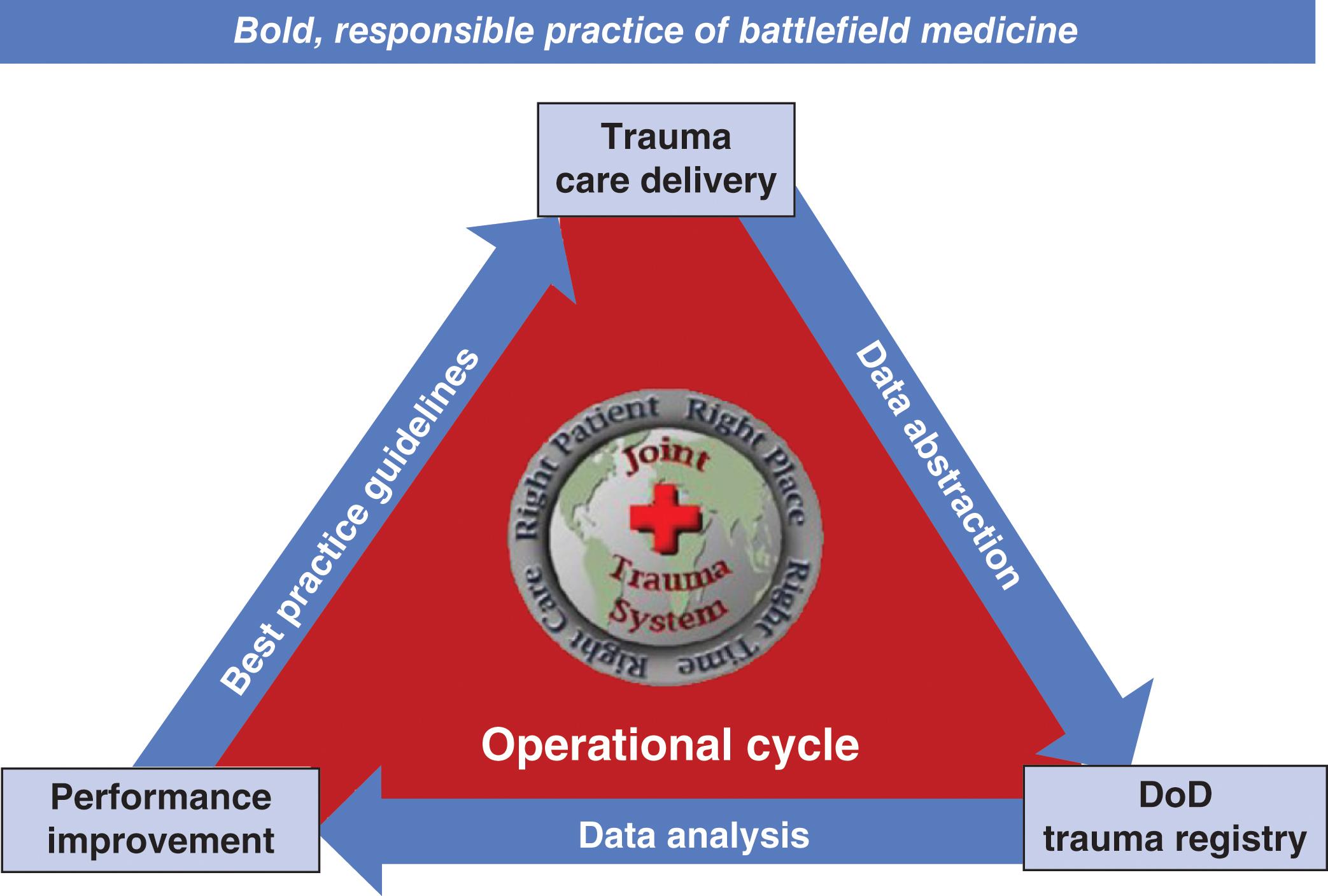
The contingency-based JTTS was matured and formally established as an enduring JTS in 2011. In recognition of its achievements, including measured reductions in combat trauma mortality, the JTS was designated as a Defense Center of Excellence in 2013. Subsequent efforts focused on transition of the JTS from a single-service (U.S. Army) to a Department of Defense (DoD)-level organization including formalization of its authorities and responsibilities. These efforts ultimately culminated in U.S. law in the 2017 National Defense Authorization Act that directed establishment of a JTS within the Defense Health Agency (DHA) to:
Serve as the reference body for all trauma care provided across the Military Health System (MHS);
Establish standards of care for trauma services provided at military medical treatment facilities (MTFs);
Coordinate the translation of research from the Centers of Excellence of the DoD into standards of clinical trauma care;
Incorporate lessons learned from the trauma education and training partnerships into clinical practice.
To assure the JTS could meet all of its responsibilities by law, the military completed an organizational assessment to determine the ideal structure of the JTS. The final report of the organizational assessment included more than 200 proposed solutions for the JTS to meet its responsibilities.
The DHA is the military’s combat support agency for health care, supporting readiness of the force by ensuring the health of military service members to deploy (medically ready force) and supporting the sustainment of a skilled and rapidly deployable battlefield medical capability (ready medical force). Within the DHA, the JTS was organized with six functional branches: the DoD Trauma Registry, Performance Improvement, Combatant Command Trauma Systems, Defense Committee on Trauma, Joint Trauma Education and Training, and Data Analysis.
Having been positioned within the DHA as a joint organization, and facing a no-growth budget environment in the MHS, JTS initially focused on the task of writing policy to implement the requirements of law. A key policy was the Combatant Command Trauma System DHA procedural instruction that defined the roles and responsibilities of the DoD and combatant command leadership to establish a trauma system in each of the U.S. military’s six worldwide geographic combatant commands, as well as describing the 11 capabilities and 12 core functions of a trauma system during peace and war. (See Figs. 3 and 4 .) The early stages of implementation of the Combatant Command Trauma System framework included identification of trauma clinical teams to support each Combatant Command surgeon’s office and completion of a tabletop exercise with each geographic region. Integration of a trauma system capability into real-world exercises and development of a deployable trauma management team and training programs will solidify a future trauma system capability that is rapidly expandable for conflict and contingency operations.
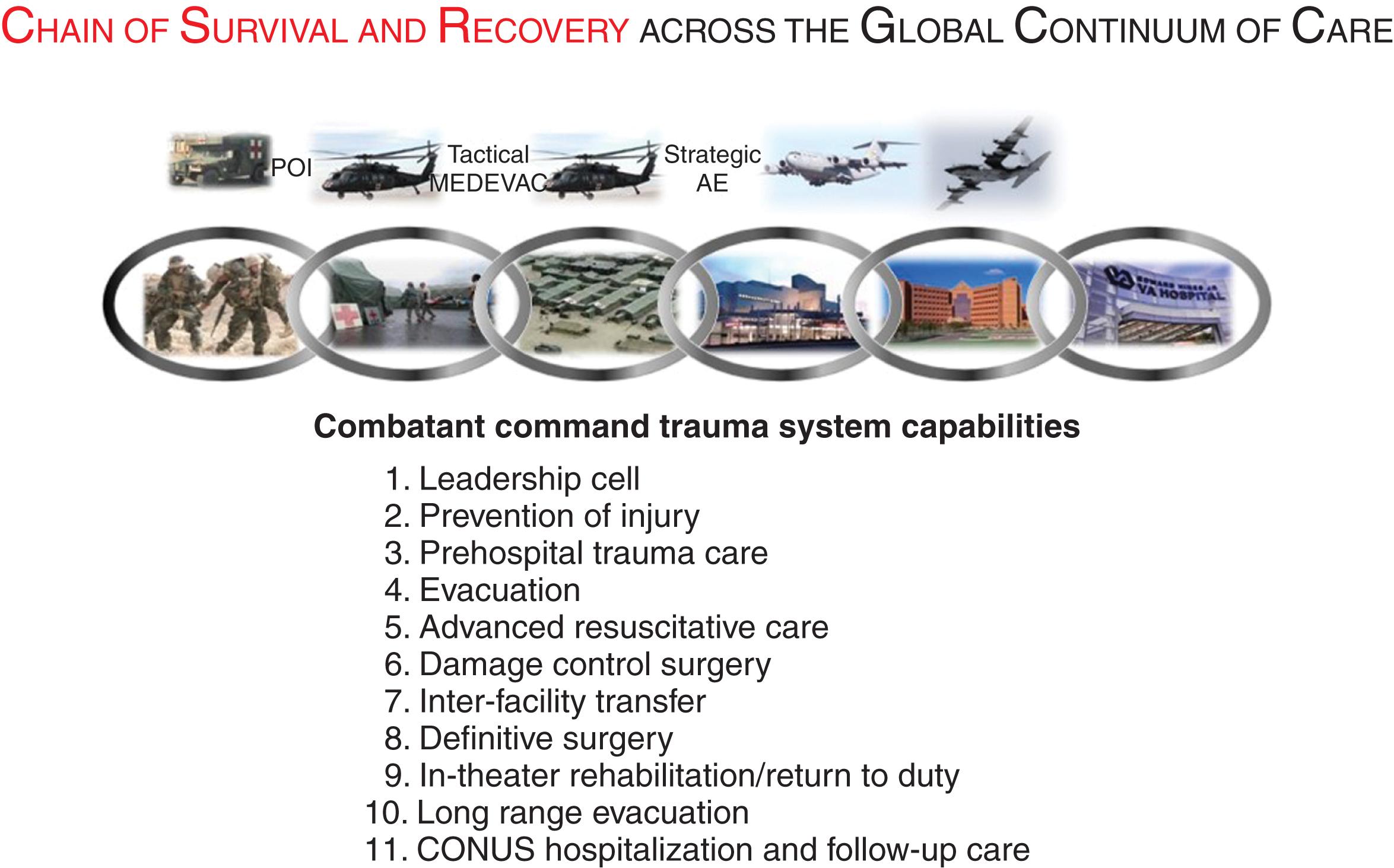
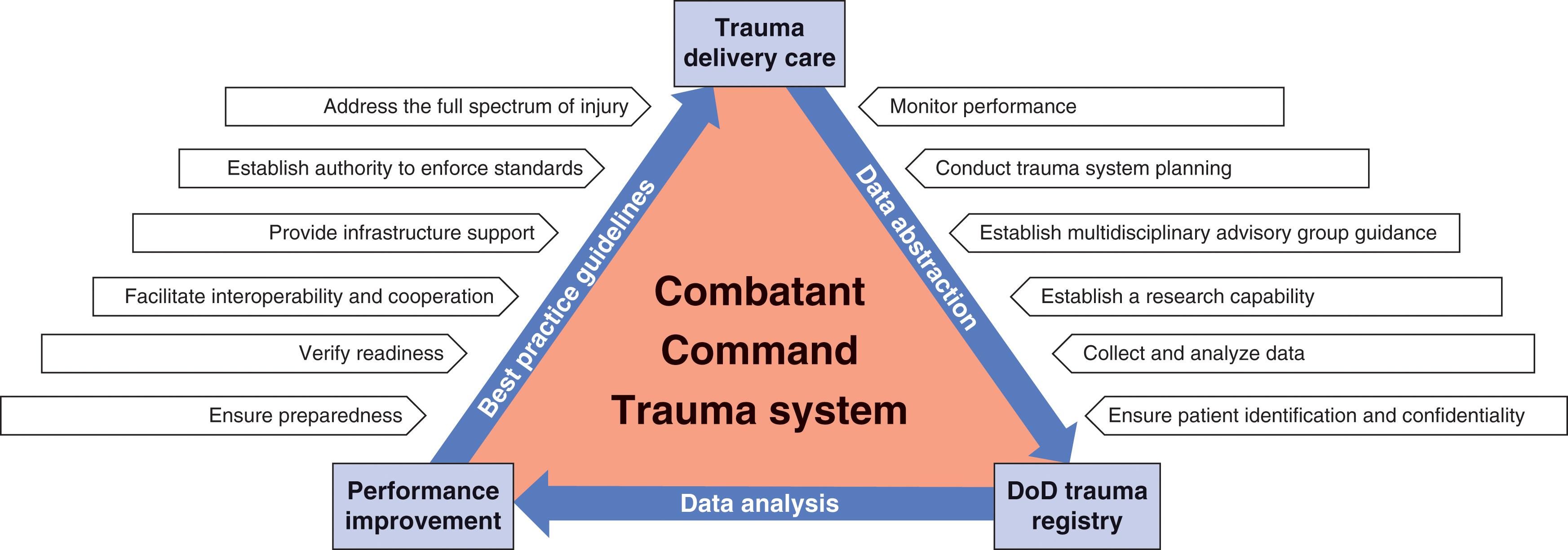
Partnerships within the DHA were leveraged to facilitate advancement of the JTS performance improvement and training mission in order to begin to address the requirements outlined in NDAA FY17. JTS was placed within DHA Combat Support, establishing a close alliance with the Armed Services Blood Program, Public Health, Medical Logistics, the Armed Forces Medical Examiner System, and the Combatant Command Operations. DHA Medical Affairs began the development of a trauma and critical care “community” integrated within a broader structure of DHA clinical communities focused on quality and standards of care across the MHS. Strategy and Plans (DHA J-5) was leveraged to develop a DHA strategy for expeditionary skill sustainment, emphasizing optimization of MTFs as readiness platforms, establishment of military-civilian partnerships for skill sustainment, integrating military and civilian trauma systems in support of the National Disaster Medical System, and excellence in simulation training, all supported with an expanded ability to track knowledge, skills, and ability metrics. Information Operations (DHA J-6) supported the development of an MHS Information Platform to establish a data link between electronic health records and multiple other DoD databases in support of a next-generation registry capability that is still in development. Education and Training (DHA J-7) partnered with JTET to develop the first standardized Tactical Combat Casualty Care courses for implementation across the entire military. Research and Development (DHA J-9) partnered with JTS to develop an implementation science approach to clinical practice guidelines, taking guideline development to the next level of implementation.
As with most health care systems, the JTS has a singular focus: the patient. Unique to the JTS is the application of this patient focus to the battlefield framework for medical care.
Casualty care begins at the point of injury (“Role 1”). (See Fig. 5 .) As opposed to prehospital care in the civilian sector, prehospital care in the combat environment is complex, often involving care while under fire, delivered in austere environments. In this setting, every service member is a potential provider, thus the care is typically provided through self-aid, buddy care, or a highly trained combat medic. This could be as simple as tourniquet application or as complex as resuscitation and tube thoracostomy. This is dependent upon the personnel and combat environment. After care has been initiated at the point of injury, the patient may be transported to a higher echelon of care, typically “Role 2” forward resuscitative care. (See Fig. 6 .) The patient may also be transported to a facility with a more robust surgical/inpatient capability (“Role 3”).
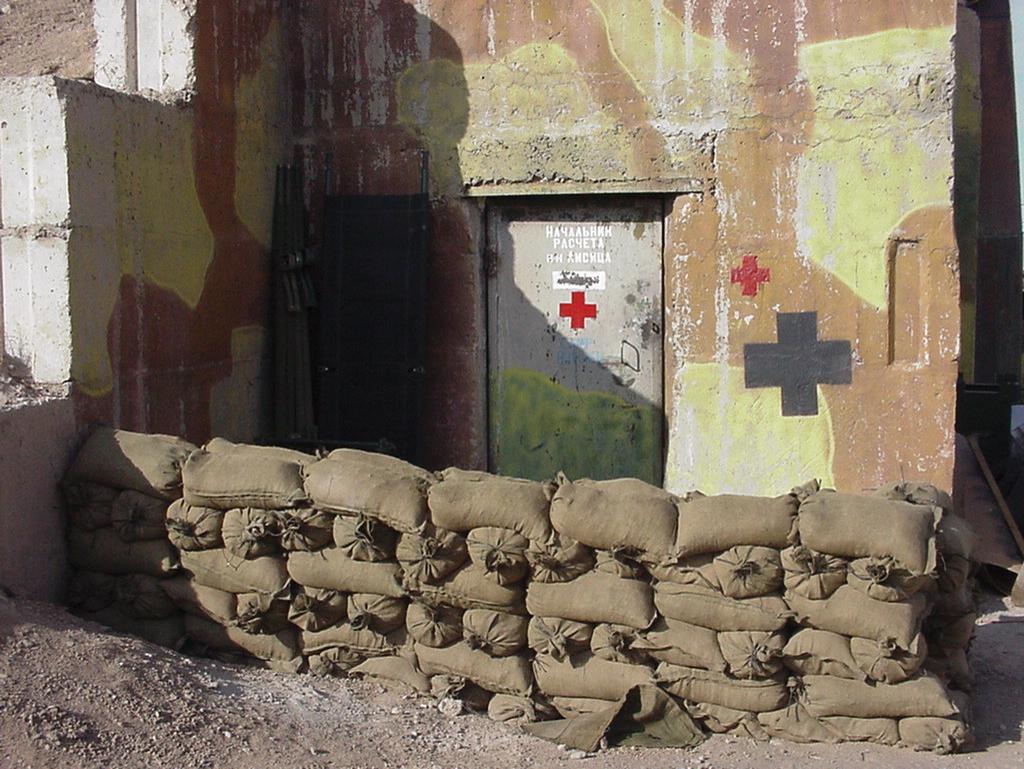
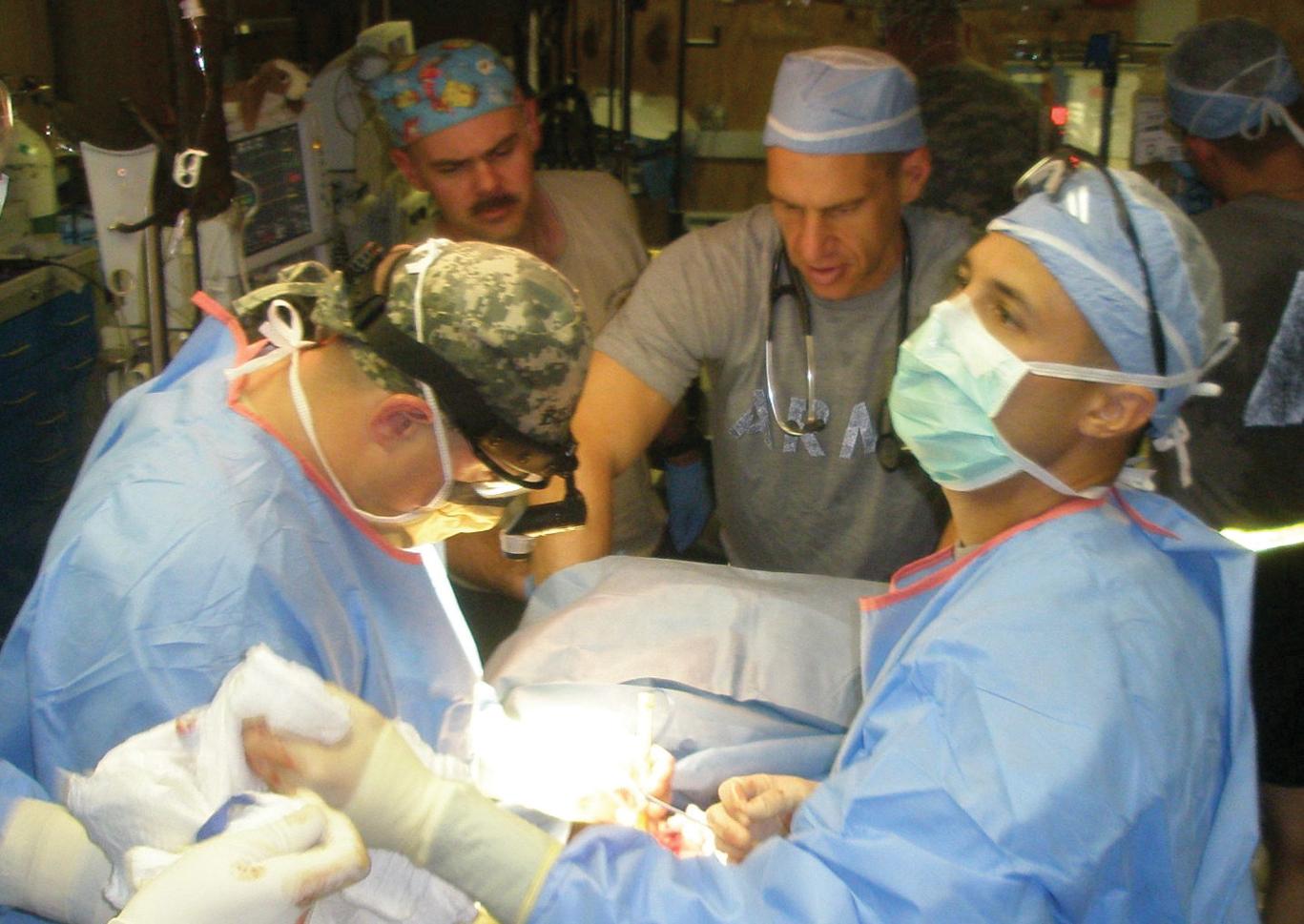
In the combat environment, patient movement can take on many forms, including ground transportation, rotary wing, or fixed wing, with platform selection based upon patient acuity, threat, mission requirements, and location of sending and receiving facility. (See Fig. 7 .) This component of care is thus termed “en route care” and is adjustable depending upon the combat environment. The goal of en route care is to continue care from the sending role of care without any degradation, as they progress through the system. The personnel involved in en route care range from combat medics/corpsman to a Critical Care Air Transport Team. The Critical Care Air Transport Team is capable of intensive care unit-level care to three ventilated patients or six or less-acute patients and can be expanded to care for up to five ventilated patients. With the various en route care capabilities, a combat casualty who is severely injured on the battlefield may arrive at a “Role 4” (full hospital care outside the combat zone) military MTF within 72 hours. (See Fig. 8 .)
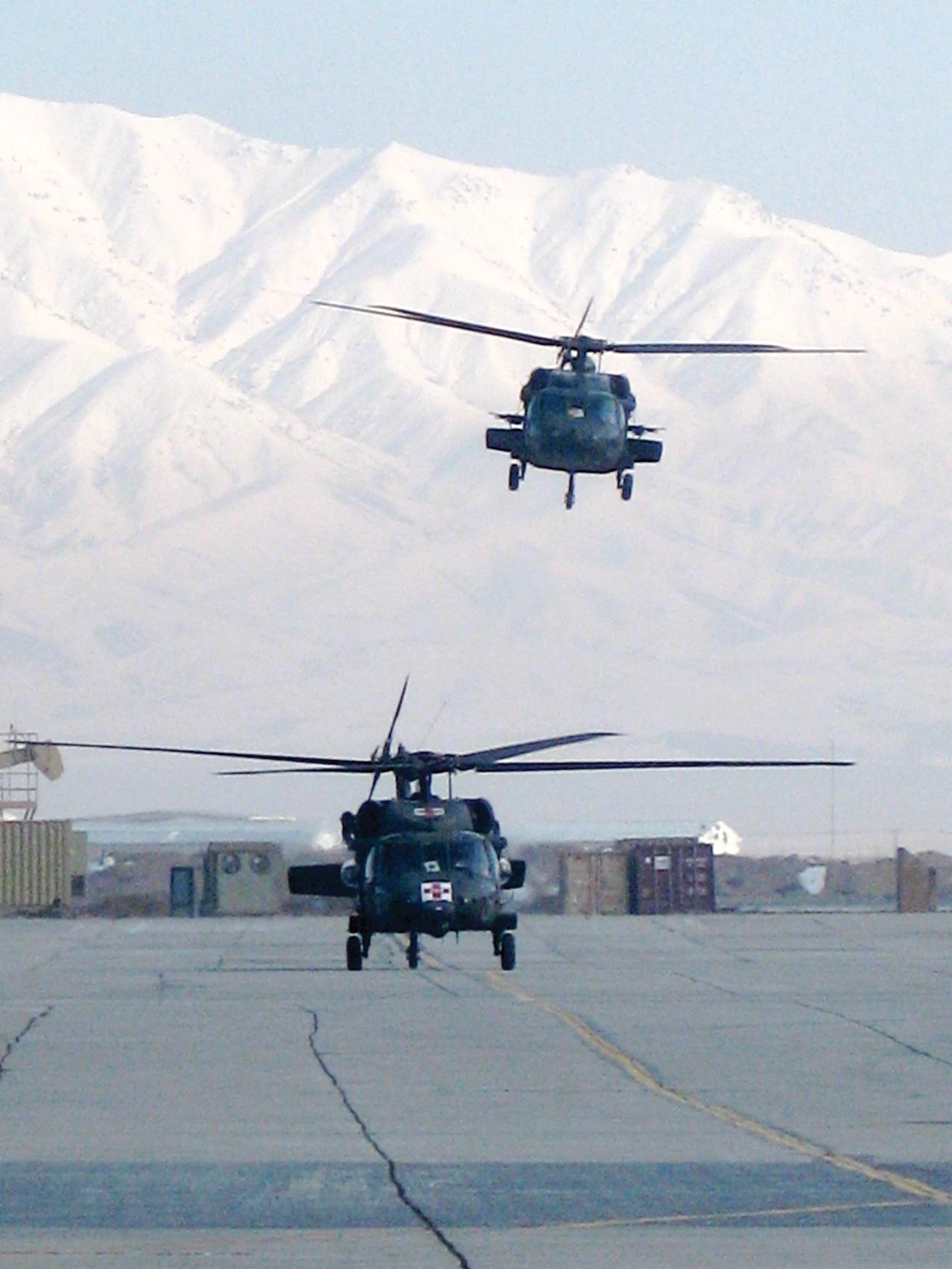
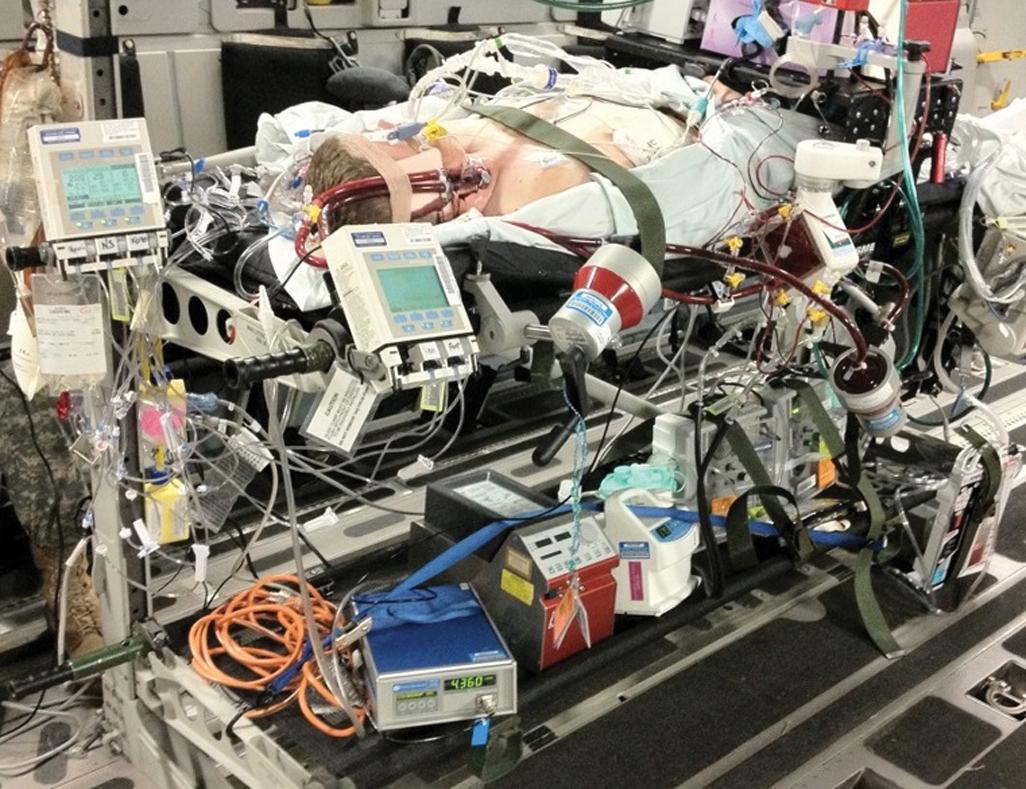
In the continental United States and outside the continental United States, MTFs are capable of definitive care for combat casualties. The MTFs are American College of Surgeons (ACS)-verified trauma centers or maintain equivalent resources for the care of combat casualties. They have a wide range of specialties and can provide definitive care for complex traumatically injured patients (traumatic brain injury, spinal cord injuries, burns, and complex reconstruction to name a few).
Lastly, a vital component to the system is rehabilitation, the goal of which is to return the patient to the highest level of function, while reducing disability. The rehabilitation process begins upon entry into the MTF and can last for several months, including years. This can occur both as inpatient or outpatient and within the military of Veteran’s Affairs (VA) system. Many severely combat-injured service members have emerged from rehabilitation to remain on active duty, even many with limb amputations and traumatic brain injuries. Many others return to productive and fulfilling life as civilian citizens and may continue longer courses of rehabilitation and restoration of function through the DoD and VA health systems.
The establishment of a trauma registry and a system-based approach to performance improvement facilitated multiple additional advances in combat casualty care. Some of the greatest leaps were facilitated by combat mortality analyses. An analysis of the causes of death in special operations forces highlighted limb hemorrhage as a cause of potentially preventable death and supported the efforts of the Committee on Tactical Combat Casualty Care and combatant commands to implement the issuing of tourniquets to every deploying service member along with training to support immediate application for life-threatening limb hemorrhage. The largest analysis of combat mortalities to date emphasized that 87% of mortalities in combat occurred in the prehospital environment, with 91% of those deaths designated as potentially survivable associated with hemorrhage. This discovery spurred intensive research, development, and training efforts to improve prehospital capabilities for hemorrhage control and resuscitation.
Advances in damage control resuscitation were facilitated by analysis of registry data in massively hemorrhaging casualties. Sparked in concept by a commentary published in the Journal of Trauma , the practice of resuscitation with exclusively blood products was associated with improved survival for ratios approaching 1:1:1 for red blood cells, plasma and platelets, and also incorporating whole blood. These concepts were then propelled to the prehospital environment, ultimately bringing advanced resuscitation capabilities to the point of injury.
With both prehospital and in-hospital deaths attributed to hemorrhage, and the majority truncal and junctional hemorrhage, new methods to rapidly control these types of hemorrhage were also explored. Various junctional tourniquets were rapidly developed and fielded with some degree of success. Additionally, the development of endovascular balloon occlusion of the aorta for trauma was sponsored by military research and successfully deployed to austere locations, with research and development toward the eventual possibility of prehospital use.
Ultimately, perhaps the greatest advance in 21st-century combat casualty care was the trauma system itself. Based on the foundation of the DoD Trauma Registry, the JTS supported a complete cycle of development of military trauma care capability gaps, needs-driven research, and rapid implementation of evidence-based trauma care to the battlefield. With the implementation of clinical practice guidelines, performance metrics, educational conferences, and a full complement of performance-improvement specialists, the JTS established methodology that has been the engine of advancement in combat casualty care, resulting in measured improvements in casualty outcomes and a case fatality rate of less than 10% at the height of the Middle East conflicts. With JTS originally modeled after civilian trauma systems established in the United States, the military trauma system evolved full circle when the National Academies of Sciences, Engineering, and Medicine recommended integration of military and civilian trauma care into a national trauma system to achieve the aim of zero preventable deaths after injury.
Become a Clinical Tree membership for Full access and enjoy Unlimited articles
If you are a member. Log in here